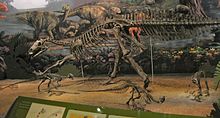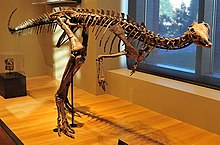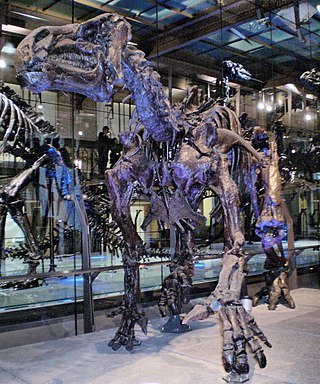
Iguanodon, named in 1825, is a genus of iguanodontian dinosaur. While many species found worldwide have been classified in the genus Iguanodon, dating from the Late Jurassic to Early Cretaceous, taxonomic revision in the early 21st century has defined Iguanodon to be based on one well-substantiated species: I. bernissartensis, which lived during the Barremian to early Aptian ages of the Early Cretaceous in Belgium, Germany, England, and Spain, between about 126 and 122 million years ago. Iguanodon was a large, bulky herbivore, measuring up to 9–11 metres (30–36 ft) in length and 4.5 metric tons in body mass. Distinctive features include large thumb spikes, which were possibly used for defense against predators, combined with long prehensile fifth fingers able to forage for food.

Hypsilophodon is a neornithischian dinosaur genus from the Early Cretaceous period of England. It has traditionally been considered an early member of the group Ornithopoda, but recent research has put this into question.

Dinosaur classification began in 1842 when Sir Richard Owen placed Iguanodon, Megalosaurus, and Hylaeosaurus in "a distinct tribe or suborder of Saurian Reptiles, for which I would propose the name of Dinosauria." In 1887 and 1888 Harry Seeley divided dinosaurs into the two orders Saurischia and Ornithischia, based on their hip structure. These divisions have proved remarkably enduring, even through several seismic changes in the taxonomy of dinosaurs.
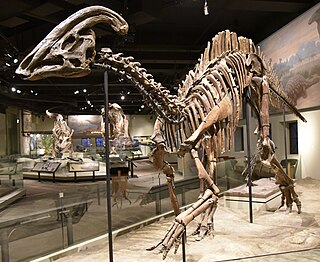
Ornithopoda is a clade of ornithischian dinosaurs, called ornithopods, that started out as small, bipedal running grazers and grew in size and numbers until they became one of the most successful groups of herbivores in the Cretaceous world, dominating the North American land. Their major evolutionary advantage was the progressive development of a chewing apparatus that became the most sophisticated ever developed by a non-avian dinosaur, rivaling that of modern mammals such as the domestic cow. They reached their apex of diversity and ecological dominance in the hadrosaurids, before they were wiped out by the Cretaceous–Paleogene extinction event along with all other non-avian dinosaurs. Members are known from all seven continents, though they are generally common in the Southern Hemisphere.

Valdosaurus is a genus of bipedal herbivorous iguanodont ornithopod dinosaur found on the Isle of Wight and elsewhere in England, Spain and possibly also Romania. It lived during the Early Cretaceous.

Ouranosaurus is a genus of herbivorous basal hadrosauriform dinosaur that lived during the Aptian stage of the Early Cretaceous of modern-day Niger and Cameroon. Ouranosaurus measured about 7–8.3 metres (23–27 ft) long and weighed 2.2 metric tons. Two rather complete fossils were found in the Elrhaz Formation, Gadoufaoua deposits, Agadez, Niger, in 1965 and 1970, with a third indeterminate specimen known from the Koum Formation of Cameroon. The animal was named in 1976 by French paleontologist Philippe Taquet; the type species being Ouranosaurus nigeriensis. The generic name is a combination of ourane, a word with multiple meanings, and sauros, the Greek word for lizard. The specific epithet nigeriensis alludes to Niger, its country of discovery. And so, Ouranosaurus nigeriensis could be interpreted as "brave lizard originating from Niger".
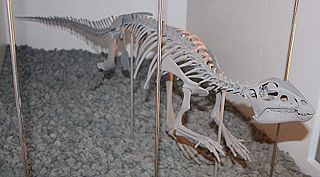
Hypsilophodontidae is a traditionally used family of ornithopod dinosaurs, generally considered invalid today. It historically included many small bodied bipedal neornithischian taxa from around the world, and spanning from the Middle Jurassic until the Late Cretaceous. This inclusive status was supported by some phylogenetic analyses from the 1990s and mid 2000s, although there have also been many finding that the family is an unnatural grouping which should only include the type genus, Hypsilophodon, with the other genera being within clades like Thescelosauridae and Elasmaria. A 2014 analysis by Norman recovered a grouping of Hypsilophodon, Rhabdodontidae and Tenontosaurus, which he referred to as Hypsilophodontia. All other analyses from around the same time have instead found these latter taxa to be within Iguanodontia.

Altirhinus is a genus of hadrosauroid ornithopod dinosaur from the Early Cretaceous period of Mongolia.

Iguanodontidae is a family of iguanodontians belonging to Styracosterna, a derived clade within Ankylopollexia.

Cumnoria is a genus of herbivorous iguanodontian dinosaur. It was a basal iguanodontian that lived during the Late Jurassic period in what is now Oxfordshire, United Kingdom.

Neornithischia is a clade of the dinosaur order Ornithischia. It is the sister group of the Thyreophora within the clade Genasauria. Neornithischians are united by having a thicker layer of asymmetrical enamel on the inside of their lower teeth. The teeth wore unevenly with chewing and developed sharp ridges that allowed neornithischians to break down tougher plant food than other dinosaurs. Neornithischians include a variety of basal forms historically known as "hypsilophodonts", including the Parksosauridae; in addition, there are derived forms classified in the groups Marginocephalia and Ornithopoda. The former includes clades Pachycephalosauria and Ceratopsia, while the latter typically includes Hypsilophodon and the more derived Iguanodontia.

Genasauria is a clade of extinct beaked, primarily herbivorous dinosaurs. Paleontologist Paul Sereno first named Genasauria in 1986. The name Genasauria is derived from the Latin word gena meaning ‘cheek’ and the Greek word saúra (σαύρα) meaning ‘lizard.’ It is hypothesized that Genasauria had diverged from Lesothosaurus by the Early Jurassic. Cranial features that characterize Genasauria include a medial offset of the maxillary dentition, a sprout-shaped mandibular symphysis, moderately sized coronoid process, and an edentulous anterior portion of the premaxilla. A distinguishing postcranial feature of Genasauria is a pubic peduncle of the ilium that is less robust than the ischial peduncle. Genasauria is commonly divided into Neornithischia and Thyreophora. Neornithischia is characterized by asymmetrical distributions of enamel covering the crowns of the cheek teeth, an open acetabulum, and a laterally protruding ischial peduncle of the ilium. Neornithischia includes ornithopods, pachycephalosaurs, and ceratopsians. Thyreophora is characterized by body armor and includes stegosaurs, ankylosaurs, Scelidosaurus, and Scutellosaurus.
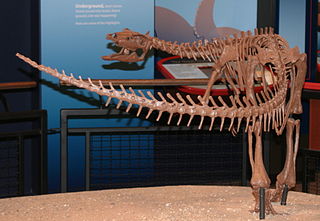
Thescelosauridae is a clade of neornithischians from the Cretaceous of Asia, North America and possibly South America. The group was originally used as a name by Charles M. Sternberg in 1937, but was not formally defined until 2013, where it was used by Brown and colleagues as the group uniting Thescelosaurus and Orodromeus, based on their phylogenetic results. During a phylogenetic revision of neornithischians by Clint Boyd in 2015, the authorship of Thescelosauridae was given to Brown and colleagues, which meant that the similar name Parksosauridae, informally defined in 2002 by Buchholz, would have had priority over Thescelosauridae. The two clades had slightly different definitions, with Parksosauridae referring to all animals closer to Parksosaurus than Hypsilophodon, but they contained the same taxa so Boyd used Parksosauridae under the assumption it had priority. However, in formalizing the clade following the regulations of the PhyloCode, Madzia, Boyd, and colleagues identified in 2021 that Sternberg was the proper authority for Thescelosauridae, giving it priority over Parksosauridae. As well, they gave Thescelosauridae the definition of the largest clade containing Thescelosaurus neglectus but not Iguanodon bernissartensis, as long as Hypsilophodon foxii was not in the group, modifying previous definitions for Thescelosauridae in order to maintain its modern use, so that the clade was not applied if Thescelosaurus fell within Hypsilophodontidae, a family that has not been recently used but may be revived if the systematic position of Hypsilophodon was solidified at some point in the future. Madzia et al. identified the analysis of Madzia et al. in 2018 as the reference analysis for the name Thescelosauridae, an analysis based on a revised version of the 2015 Boyd analysis.

Elrhazosaurus is a genus of basal iguanodontian dinosaur, known from isolated bones found in Early Cretaceous rocks of Niger. These bones were initially thought to belong to a species of the related dryosaurid Valdosaurus, but have since been reclassified.

Ankylopollexia is an extinct clade of ornithischian dinosaurs that lived from the Late Jurassic to the Late Cretaceous. It is a derived clade of iguanodontian ornithopods and contains the subgroup Styracosterna. The name stems from the Greek word, “ankylos”, mistakenly taken to mean stiff, fused, and the Latin word, “pollex”, meaning thumb. Originally described in 1986 by Sereno, a most likely synapomorphic feature of a conical thumb spine defines the clade.
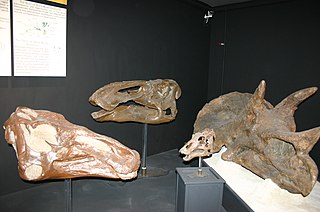
Cerapoda is a clade of the dinosaur clade Ornithischia, that includes pachycephalosaurs, ceratopsians and ornithopods

Elasmaria is a clade of ornithopods known from Cretaceous deposits in South America, Antarctica, and Australia that contains many bipedal ornithopods that were previously considered "hypsilophodonts".

Jeholosauridae was a group of herbivorous neornithischian dinosaurs from the Cretaceous Period. The family was first proposed by Han et al. in 2012. The jeholosaurids were defined as all neornithischians more closely related to Jeholosaurus shangyuanensis than to Hypsilophodon foxii, Iguanodon bernissartensis, Protoceratops andrewsi, Pachycephalosaurus wyomingensis, or Thescelosaurus neglectus. The Jeholosauridae includes the type genus Jeholosaurus, and also possibly Yueosaurus, Changchunsaurus, and Haya.
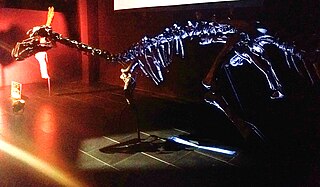
Proa is a genus of basal styracosternan iguanodont known from the Early Cretaceous Escucha Formation of Teruel Province, Spain.

Hadrosauromorpha is a clade of iguanodontian ornithopods, defined in 2014 by David B. Norman to divide Hadrosauroidea into the basal taxa with compressed manual bones and a pollex, and the derived taxa that lack them. The clade is defined as all the taxa closer to Edmontosaurus regalis than Probactrosaurus gobiensis. This results in different taxon inclusion depending on the analysis.
